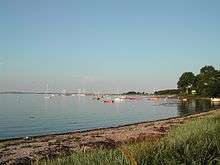Flensburg Firth

Flensburg Firth or Flensborg Fjord[1][2] (German: Flensburger Förde; Danish: Flensborg Fjord), is the westernmost inlet of the Baltic Sea. It forms part of the border between Germany to the south and Denmark to the north. Its length is either 40 or 50 km, depending to the definition of its limits. It has the largest surface of all Förden and East Jutland Fjorde, which are a special type of inlets, different from geological fjords.
Two peninsulas, Broager peninsula on the northern side and Holnis peninsula on the southern side divide the inlet in an outer and an inner part. West of them, near the Danish coast, there are two small Islands called Okseøer.
On the Danish side, outer part of the northern limits of the firth is formed by the island of Als with the town of Sønderborg. Towards the west, continuing on the Danish side are Broager, Egernsund, Gråsten, Rinkenæs, Sønderhav, and Kollund.
In Germany at the Danish border there is Harrislee, at the inner end of the inlet the town of Flensburg, east of it on the southern shore the town of Glücksburg and the villages Munkbrarup, Langballig, Westerholz, Quern, Steinberg, Niesgrau, Gelting, and Nieby.
The Tourist attraction of the Flensburg Firth are the church of Broager, the Ox isles, the Sønderborg Castle, the Naval Academy Mürwik (named the Red Castle) and the harbor of Flensburg.
References
External links
- Map (in German)
- Google maps satellite image
| Wikimedia Commons has media related to Flensburg Firth. |
Coordinates: 54°47′45″N 9°25′44″E / 54.79594°N 9.42902°E